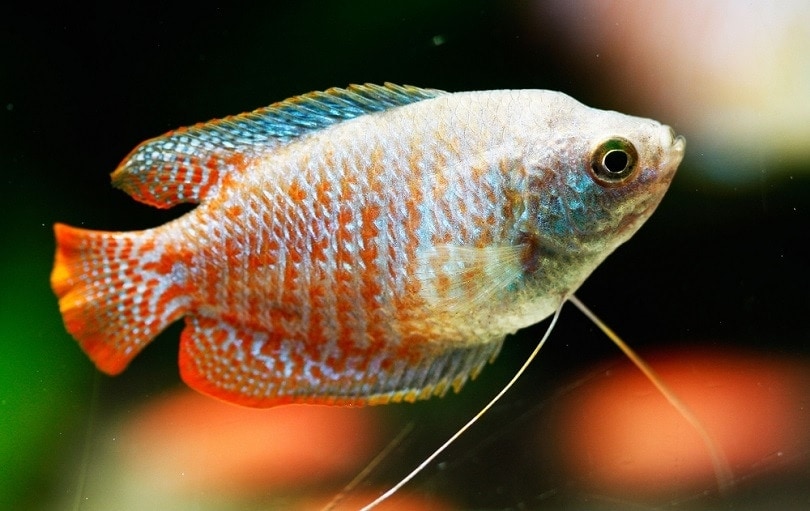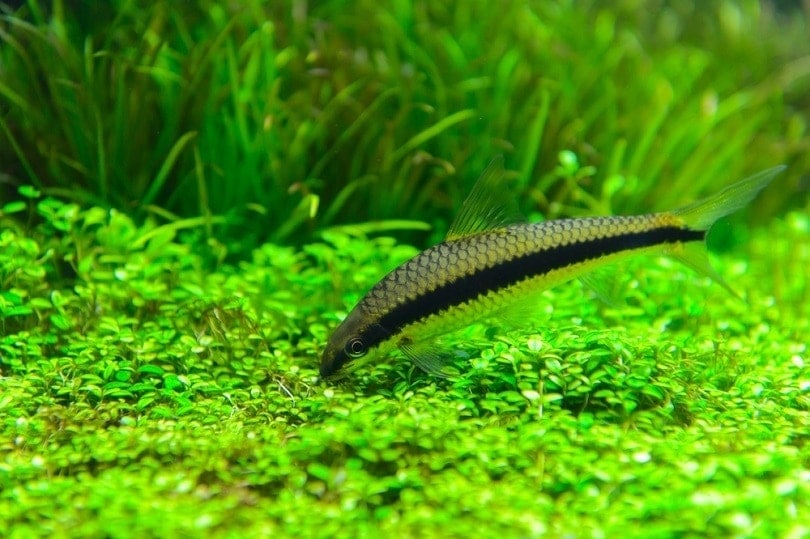How Big Do Gourami Fish Get? Average Size & Growth
Updated on

There are multiple varieties of Gourami fish that are available in the aquatics market, and although they are generally similar in appearance, they are all eye-catching. Gouramis sport beautiful colors and patterns, and their large, flat bodies make them hard to miss. How big do they get, though?

Facts About Gourami Fish
- Gouramis have a labyrinth organ. This organ is present in a variety of fish species, including Goldfish, and it allows fish to breathe regular air. Labyrinth organs are not true lungs, but they do function in a similar way. They primarily breathe through their gills like most fish, though.
- There are multiple Gourami species on the market, so the specific needs can vary. They are all tropical fish, but their temperament can vary from fully peaceful to highly territorial.
- Gouramis and Bettas belong to the same order of fish. Both species belong to the Anabantiformes order, but they are not compatible tank mates and will fight with each other for territory. There are over 200 species of fish in the Anabantiformes order.
- Gouramis are omnivorous fishes. They will eat things like algae and insect larvae, but they are not picky eaters.
- Gouramis are mouth brooders. This means that Gouramis carry their eggs in their mouth while they incubate. Considering a Gourami can lay 800–1,000 eggs in one clutch, that’s a lot of eggs to hold!

Gourami Fish Size and Growth Chart
There are multiple Gourami species routinely sold in the aquatics trade, but there are a handful that you’re most likely to spot in the average pet or fish store. Dwarf, Flame, Neon Blue Dwarf, and Honey Dwarf Gouramis are the most common small Gourami varieties. You may be able to find some of the larger varieties in some stores, like Pearl, Blue, and Kissing Gouramis.
The largest Gourami species is the Giant Gourami, which grows up to 28 inches, although most don’t exceed 18 inches. This Gourami species is most commonly raised for food, but they can also be used for control of invasive aquatic plants due to their voracious appetite for plants. Some people even keep these big fish as pets, and the Giant Gourami can live up to 20 years.
| Species | Average Purchase Size | Maximum Size |
| Sparkling Gourami | 0.5–1 inch | 1.5 inches |
| Licorice Gourami | 0.5–0.75 inches | 1.25 inches |
| Flame Gourami | 1 inch | 2 inches |
| Dwarf Gourami | 1 inch | 2 inches |
| Honey Dwarf Gourami | 1 inch | 2 inches |
| Neon Blue Dwarf Gourami | 1 inch | 2 inches |
| Chocolate Gourami | 1–1.5 inches | 2.5 inches |
| Blue Dwarf Gourami | 2 inches | 3.5 inches |
| Blue Paradise Gourami | 1.5–2 inches | 4 inches |
| Pearl Gourami | 2 inches | 4 inches |
| Kissing Gourami | 2 inches | 6 inches |
| Blue Gourami | 2 inches | 6 inches |
| Gold Gourami | 2 inches | 6 inches |
| Opaline Gourami | 2–2.5 inches | 6 inches |
| Giant Gourami | 2–3 inches | 28 inches |

When Does a Gourami Fish Stop Growing?
While the lifespan can vary between species, most Gourami species can live to 4–5 years of age. Some of the larger varieties will take quite a while to reach their full size, with some continuing to grow up to 18 months of age. Some Gouramis will grow until their maximum size is reached, so it is possible for a Gourami to grow beyond 18 months of age.
Factors Affecting the Size of Gourami Fish
There are a handful of factors that will impact the growth rate and mature size of a Gourami fish. The most important factors that impact growth are water parameters and quality. Poor water quality can significantly stunt the growth of a fish, as well as lead to a shortened lifespan.
Nutrition is another important factor that can impact the size and growth of a fish. Not being fed enough or being fed a low-quality diet without appropriate nutrition can lead to slow growth rates and small overall size.
Keeping a Gourami fish at an inappropriate water temperature can influence their growth and size. Oftentimes, warmer water can cause faster growth rates, while cooler water can slow growth. However, keeping a fish in warmer water than necessary can lead to an increased risk of disease and a shortened lifespan.

Ideal Diet for Maintaining a Healthy Weight
To support healthy growth and overall size for your Gourami fish, provide them with a high-quality diet that provides all the necessary nutrients for healthy growth. As omnivores, Gourami needs a varied diet that provides both plant and animal matter, supporting healthy growth.
High-quality pellet food is a good base diet for your Gourami, but they can also get tasty treats like frozen bloodworms, brine shrimp, and community foods.
How to Measure Your Gourami Fish
The safest way to measure your Gourami is to use a soft tape measure against the side of the tank when your Gourami is near the glass. You may be able to use items within the tank to help you gauge size as well. Just keep in mind that if you’re measuring through the glass, some types of glass create more distortion than others, so try to account for glass distortion when measuring your fish.
It is possible to measure your Gourami by removing them from the water or holding them in your hand under the water. However, it’s important that you make sure you wash your hands thoroughly before and after putting them in the tank.
Whenever possible, keep your fish under the water. If you do choose to remove them from the water, keep them directly above the water to prevent them from jumping and hitting the floor.


Conclusion
Gouramis are beautiful fish that come in a wide range of colors and markings. Most species of Gourami are relatively easy to care for, making them suitable for many fish keepers. They can add an interesting look and variety to your tank, but many Gourami species are territorial fish that should be housed in community tanks with caution.
Make sure to read up on the temperament and behaviors of the species of Gourami you’re considering before bringing it home, especially if you plan to keep them in a community tank. Most Gourami are not suitable tankmates for other territorial fish species.
Featured Image Credit: Juan Carlos Palau Díaz, Pixabay










